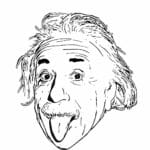Everyone’s seen the photo: Albert Einstein, the epitome of genius, playfully sticking out his tongue. But why has this image become so iconic? More than just a funny picture, it offers a glimpse into Einstein’s playful personality and his willingness to defy expectations. This seemingly simple gesture continues to resonate with people around the world, reminding us that even the most brilliant minds can embrace humor and challenge conventions.
The Moment a Genius Got Goofy
Let’s rewind to March 14, 1951. It’s Einstein’s 72nd birthday, and he’s leaving a party at Princeton University. Surrounded by well-wishers and a flurry of camera flashes, he’s likely feeling the weight of constant attention. Among the photographers is Arthur Sasse, who captures an extraordinary image just as Einstein, perhaps a bit weary of forced smiles, sticks out his tongue.
You might expect a man of Einstein’s stature to disapprove of such a seemingly irreverent photo. Surprisingly, he loved it. The image resonated with his own playful nature and served as a refreshing counterpoint to the seriousness often associated with science. Einstein ordered numerous prints, even cropping the photo to focus solely on his mischievous expression.
A Legacy More Than Tongue-in-Cheek
The photo’s impact was immediate and far-reaching. It quickly spread through newspapers and magazines, captivating the world with its unexpected glimpse into the human side of genius. People connected with Einstein’s willingness to be silly, to embrace his playful side even amidst his extraordinary intellect.
But the photo’s significance runs deeper than a lighthearted moment. It has evolved into a symbol of:
Humanizing Genius
The image shatters the stereotypical image of the unapproachable, serious scientist. Einstein’s playful defiance reminds us that brilliance doesn’t have to be rigid; it can be playful, accessible, and even a little rebellious.
Championing Individuality
Sticking out his tongue became an act of quiet rebellion, a subtle yet powerful message encouraging us to embrace our quirks and challenge expectations. Einstein’s gesture suggests it’s okay to deviate from the norm, to think differently, and to express ourselves authentically.
The Power of a Moment
The enduring popularity of the photo, auctioned for over $72,000, speaks to its cultural and commercial value. It highlights how a single, fleeting moment can capture the world’s imagination and spark conversation across generations. The image continues to inspire us to approach life with a sense of humor, curiosity, and a willingness to defy the expected.
Beyond the Tongue: Exploring Deeper Questions
Einstein’s iconic photo invites us to delve deeper into fascinating questions:
Did Einstein Have Difficulty Speaking?
The image of his tongue has led some to wonder about Einstein’s speech. While some accounts suggest he was a late talker, there’s no evidence of a speech impediment. He communicated complex scientific ideas clearly and eloquently, leaving behind numerous written works and captivating audiences with his lectures. The photo, likely a playful response to persistent photographers, should not overshadow his eloquence and mastery of language.
For more insights, explore these articles:
What Makes a Pose Iconic?
Why do certain images capture our collective fascination while others fade into obscurity? Einstein’s tongue photograph prompts us to consider the elements that elevate a simple gesture to iconic status.
For a deeper dive into this topic, check out:
Einstein’s Enduring Legacy
The enduring power of Einstein’s tongue photo reminds us that true genius lies not only in groundbreaking discoveries but also in the ability to connect with humanity on a deeper level. It encourages us to approach life with a bit of humor, a dash of rebellion, and a reminder that even the most brilliant minds can appreciate a good laugh.
- SYBAU See You Baby Meaning: Gen Z Slang Evolves - July 1, 2025
- Unlock Your Inner Youth: Lifestyle Secrets for a Vibrant Life - July 1, 2025
- Decode SYBAU Meaning: Gen Z Slang Explained - July 1, 2025






